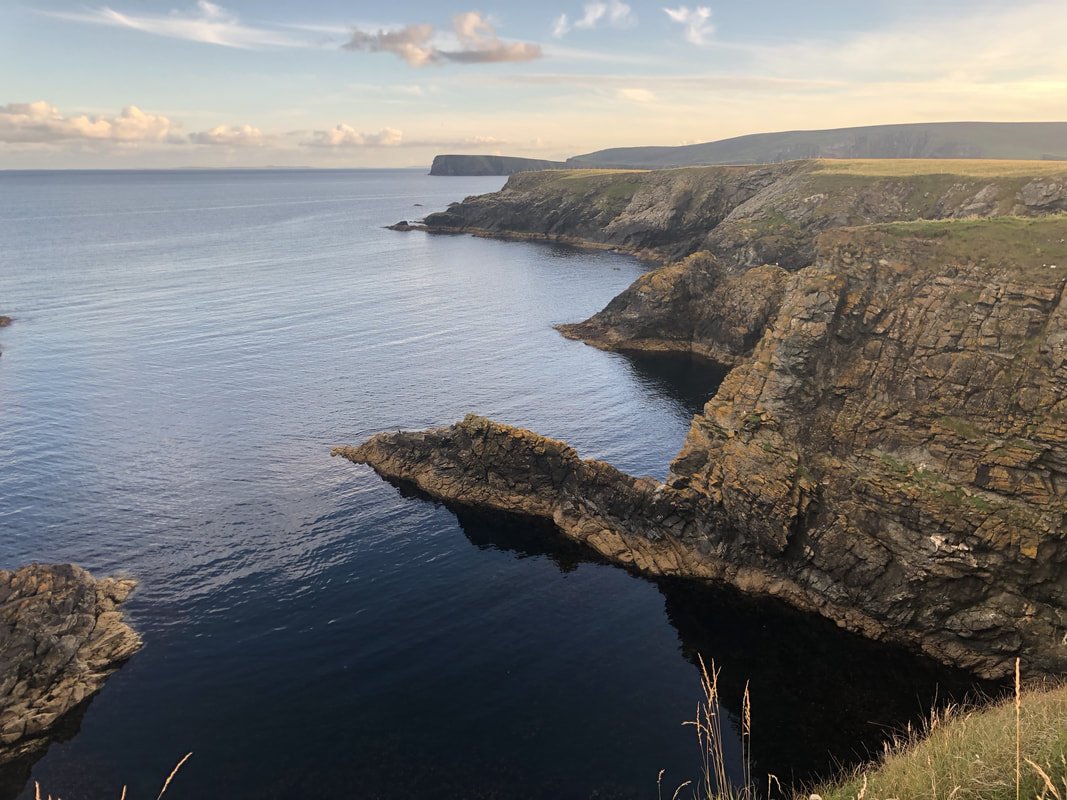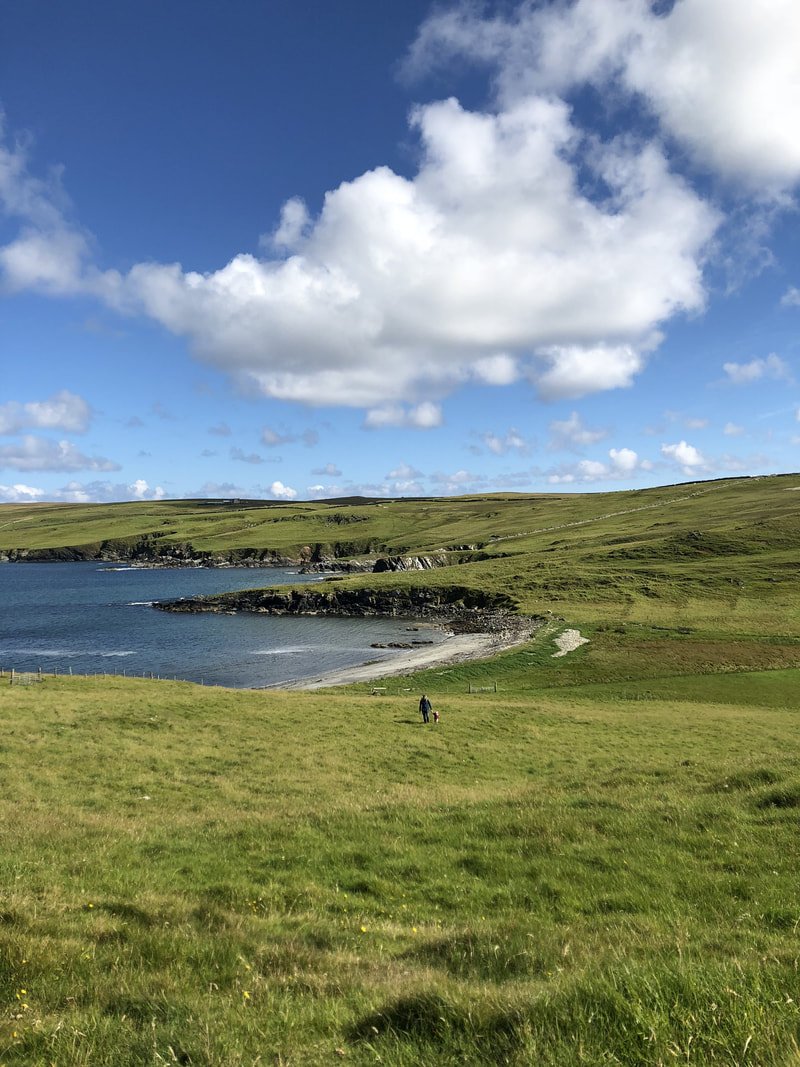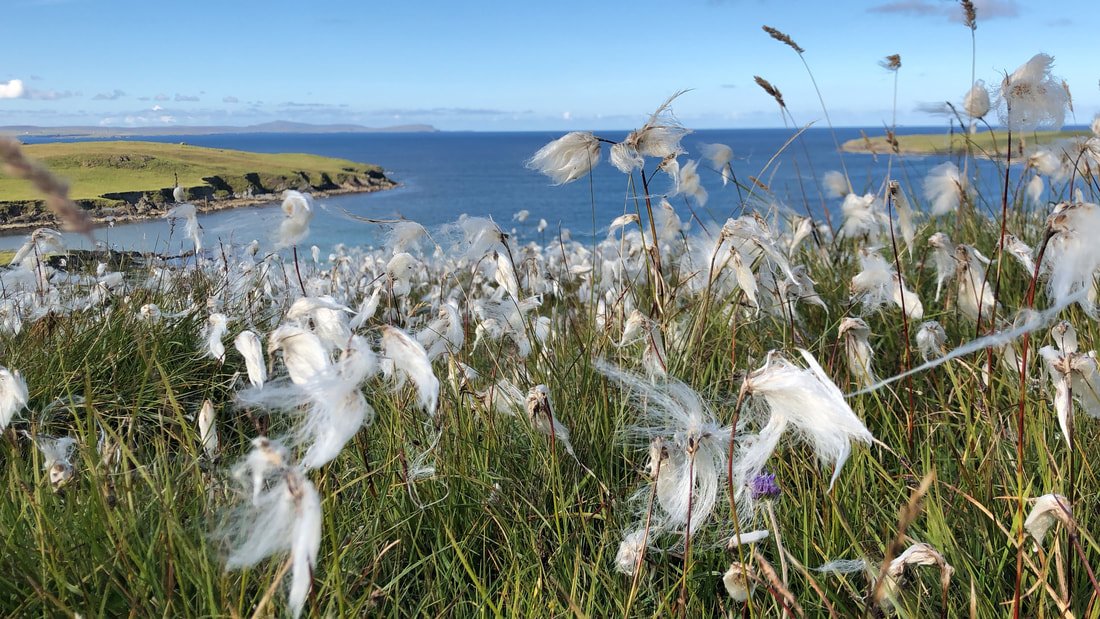In the Garden of Shetland: A Foray through Fetlar (part one)
We recently spent a few nights in Fetlar, endearingly known as The Garden of Shetland. In anticipation of the schools going back, and trying to make the most of the time we had left of the holidays we booked the Aithbank Camping Böd, former home of storyteller Jeemsie Laurenson. The weather was glorious and Fetlar shone, like a glistening jewel in the North Sea, giving us the best it had to offer.
In this blog I will attempt to give you an account of our travels through the Garden of Shetland, and what we discovered along the way, and you're in luck as this one's a two-parter!
Part One:
Travelling with little people means that you need plenty of picnic stops along the way!
Fetlar is a walkers mecca, offering a multitude of coastal walks, secluded beaches, and archaeology peppered landscapes. Travelling with two bairns in tow meant that there was much bribery and Haribo sweeties deployed and many picnic stops made to enable us to see as many of the sites as possible in the few days that we had. So, armed with the sweeties we were able to explore the island with the minimum of protestations from those in short trousers and, in fact, the constant stops meant that we were able to really slow down and take in the sights and sounds on offer and appreciate the beauty.
Getting to Fetlar is relatively easy, although booking ferries is recommended. We made the short journey across Yell Sound, from Toft before heading north through Yell to catch the ferry from Gutcher (Yell) to Hammersness (Fetlar), briefly touching base at Belmont (Unst) en route.
I sat out on the deck (mainly to avoid the boredom induced World War Three which was brewing in the car) and I watched the seabirds as they dived, the tysties (black guillemots) bobbing around on the glistening sea as a distant yacht made steady progress around Urie Ness, catching the wind coming off the hill. It was all very peaceful and the experience of being in this area on the open water reminded me of when I was young and went to the fishing with dad.
I remember towing (for scallops) in a spot called (I think) the 'trink', not far from Fetlar, on the east coast. Listening to the traffic report on Radio 2, I remember thinking at the time, just how far removed we were from the busy traffic-induced rat race and the stresses and strains of the ever congested M25 and, at that moment, civilisation seemed to me, a very faraway world, yet to dad, a fisherman, this was his every day, this was his 9-5. Isn't it funny how a moment can transport you back in time and shake out old memories?
(If you’re interested, I recorded a podcast episode about life at the fishing with dad that you can listen to here.)
Fetlar coming into view against a glistening sea.
It was busy on the Bigga. We were the only passengers.
Arriving in Fetlar, we made our way to the camping
Böd for lunch. Böd's, located throughout Shetland, were traditionally buildings used to house fishermen and their gear during the fishing season. Today they form a network of basic accommodation, operated by Shetland Amenity Trust for those who want a simple, no-frills holiday on a budget. The Böd, despite being sparsely furnished was clean and sited in a beautiful location, overlooking the Aith beach and across the bay to Lambhoga.
Aithbank, Fetlar. This is a camping Bod operated by Shetland Amenity Trust.
Aithbank, Camping Böd and former home of Storyteller, Jeemsie Laurenson.
Words of advice for those visiting Aithbank
Aithbank offers excellent value, it is clean(ish), tidy and reasonably well equipped. I would say however that in general the
Böds in Shetland, operated by the Amenity Trust, have been rather neglected in recent years and, despite being very good value, they offer very little comfort and lack many basic necessities.
The lack of maintenance and investment back into the buidlings have meant that many are damp, ill-equipped and uncomfortable.
Here are some tips to ensure maximum comfort when visiting:
The trials and tribulations of slicing loaf with a paring knife at Aithbank.
Pack a kitchen knife if taking unsliced bread. According to the other guests this rule can be applied to all Böds in Shetland as they discovered during their Böd tour that all are supplied only with paring knives.
Bring a bath mat for extra comfort for stepping out the shower - the stone floor can be slightly unpleasant (and it's right beside the toilet).
Bring a cushion as the furnishings in the lounge are humble at best and bums need a soft landing after a long day hiking. There is very little comfort in the bod and I wonder why the custodians don't invest in a few basic furnishings?
And probably the most important tip I can give you is BRING A CORKSCREW or a screw top bottle - personally I think this one is a household basi' and should be included!
At £12 a night, Aithbank really is good value for money. I would recommend staying there if you are looking for a cheap holiday.
For more information and for booking, please visitwww.camping-bods.com.
Sanderlings footprints on the beach
If you are looking for a little more comfort during your stay in Fetlar, read about our stay at The Lodge, a beautifully renovated and comfortable cottage by the sea.
Walk 1
- Everland to Gruting circular
(3 hours inc. picnic & short legs)
The first walk was from the house at Everland, where we met Layla (the dog) who joined us as we headed down to the beaches at Honga Ness via the old chapel site. At the beach we watched a group of Sanderlings chasing the incoming waves as the bairns dug in the sand.
Views across Gruting in Fetlar.
The sandy beach at Honga Ness.
From the beach there are views across to the house at Smithfield, a grand home, now roofless. It was formerly the home of the Smith family until they emigrated to Australia in the 1860s and the house became uninhabited. The roof was later removed and it is now a category C listed building which is designated as at risk, the house, built in 1815 is described as:
'unusually grand for this type of building in Shetland, and its formal relationship with the booth (nearby, by the shore) serves as a reminder of the importance of the sea in trade and communication during the 19th century'.
From here we made our way to arguably the most unusual building on the island, the round-house at Gruting. Not a neolithic or iron age round-house but the bolt hole of an 19th century eccentric.
The roundhouse built by Sir Arthur Nicolson, Brough Lodge, Fetlar.
The round-house at Gruting, built by Sir Arthur Nicolson of Brough Lodge.
The round-house has a very curious story attached to it, which I'll share, and any brave campers or would be ghost-hunters can go there, stay, and report back with their findings.
The house was built after the fertile valley at Gruting was cleared during the 1840s. Fetlar was badly hit by the clearances which affected much of the Highlands and Islands throughout the 19th century when landowners decided that large-scale sheep farming was more profitable than tenant farmers who were in turn forcibly removed from their homes in favour of sheep.
Nestled in the heart of the valley, and said to be built from the stone of the cleared houses from the area, sits Arthur’s impressive roundhouse – not Neolithic, or Iron Age but, rather, a bolt-hole for this 19th-century eccentric landowner who owned the imposing mansion at Brough Lodge, a few miles away from the folly.
Sir Arthur Nicolson decided to build a summer house in the now quiet valley, secluded from his family home at Brough. He designed his summer house in a French fashion, the lower part being made from stone and the upper floor constructed of wood. Once complete Sir Arthur, on his horse Jolly, made his way to the newly constructed summerhouse to spend the night, in perfect solitude, away from the family demands at home.
The evening went well until Sir Arthur went to bed where he was then kept awake, and left afraid by an incessant banging and knocking which echoed through the darkness outside. Nobody was there and eventually, the noise became too much to bear and he abandoned his bed, galloping back to Brough Lodge, much the wearier of his staycation in the summerhouse.
An explanation, provided by the minister at the time, said that the noise could be the spirits of the crofters whom he had evicted from the surrounding area in the 1840s who had, in fact, not departed the valley but had come back to haunt him for his misdeeds against them.
(I wrote more about Shetland’s haunted places here.)
Bog Cotton in Fetlar.
Lucky Minnie's Oo (Bog Cotton) at Gruting, Fetlar.
Enjoyed part one? You can read part two here.










